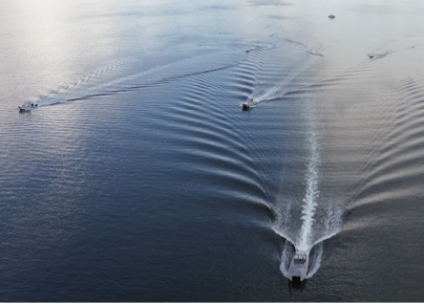By Pierre Tran
Paris – Two European arms companies, KNDS France and MBDA, recently pointed up their hefty investment to boost production of cannon shells, artillery, and missiles, indicating a willingness to anticipate orders, and their access to extensive funds.
The willingness of those two privately held companies to invest in new plant and parts could be seen in contrast to companies listed on the stock exchange showing reluctance to build up weapon stocks until they win government orders.
That commitment to invest among some unlisted companies also shows how prime contractors have own funds and can tap bank loans and capital markets, while small and medium companies in the supply chain have struggled to find working capital, just to keep up with present orders.
State-owned KNDS France invested €600 million ($648 million) to ramp up production of its Caesar artillery and 155 mm 52 caliber shells from summer 2022, in expectation of orders from France and European Allies.
The scale of that €600 million investment by the KNDS French unit can be seen in the light of the KNDS group reporting March 27 2024 sales of €3.8 billion, up from €3.3 billion the previous year; orders of €11.2 billion, up from €7.8 billion; and an order book of €23.5 billion, up from €16 billion.
There was “satisfactory profitability in line with industry expectations,” the KNDS group said in a statement with the financial results.
KNDS is a Franco-German group comprising the family controlled KNDS Deutschland and KNDS France, with the head office in Amsterdam.
On the French unit’s investment of own-funds for the Caesar, contracts for 78 artillery systems eventually landed. Kyiv ordered six of the truck-mounted cannons in September 2023, with allies ordering the remaining 72, the weapons to be shipped to Ukraine in 2024 and early 2025.
MBDA said March last year the missile company would invest €2.4 billion between 2023-2028 to speed up production, in response to calls by France for higher productivity. That planned investment compared to 2024 sales of €4.9 billion, up from €4.5 billion in the previous year; orders of €13.8 billion, up from orders of €9.9 billion; and an order book of €37 billion, up from €28 billion.
MBDA is a private company jointly owned by Airbus, BAE Systems, and Leonardo, which are listed on European stock exchanges. Those parent companies would have had to approve the investment drive of the missile manufacturer, and the expected return.
Contracts First
French listed companies such as Thales have been ready to invest but have been waiting for arms contracts, a defense specialist said. The industrial workplace has lacked financing from the government to tool up.
For privately held companies such as KNDS France, there was a distinct political dynamic. The state ownership of the KNDS France unit might be seen as making it easier for managers to opt for raising production before government orders rolled in.
It remains to be seen whether KNDS’s readiness to build up stocks without orders will continue if the group completed a reported plan to list on the Frankfurt stock exchange, with prospective shareholders looking closely at capital expenditure and return on capital.
Meanwhile, MBDA has called for client nations to pool their orders for missiles.
There was a case to be made for discounts on joint orders, a second specialist said.
The pursuit of new weapons stems from French support for Ukraine in its fight against Russian forces, and a drive to build up low national stocks of arms, made more pressing from what appears to be the Trump administration’s scorn for European allies.
“Collective buying” in the European Union made sense, Steven Everts, director of the European Union Institute for Security Studies (EUISS), a think tank, told March 26 the Anglo-American Press Association (AAPA).
The bulk of European spending on arms was at the national level and based on a sovereign decision, he said, but there was a case to be made for buying European-built equipment and on a collective basis.
The European Commission has pledged €1.5 billion for the European Defence Industry Programme (EDIP) for 2025-2027, and there is the European Defence Industrial Strategy (EDIS), both seeking to support companies in the 27 E.U. member states.
“Let’s see how it goes,” he said.
Political Support
A political agenda was set with a June 2022 speech by President Emmanuel Macron at the Eurosatory trade show, when he said the Russian invasion of Ukraine meant France was moving to a war economy.
The armed forces minister, Sébastien Lecornu, followed that up by holding a September 2022 meeting with industry leaders, chiefs of staff, and the head of the DGA procurement office. The minister called on companies to build up stocks of raw material, and companies pledged to speed up deliveries.
However, companies quietly talked of a lack of orders, making the war economy more talk than a bankable walk.
It remained for Bercy, the finance ministry in modern buildings and a helicopter pad on the roof, to find the payment credits to make down-payments, and pay up when deliveries were made. Those payment credits came after authorizations were made, to allow an order to be placed – arguably the easy part.
“There were many statements, but no contracts,” the specialist said, from the industry point of view.
From the government’s view, there was “dialog” with industry to speed up the production cycle, the specialist said. But there was something of a structural problem, with Bercy holding the budget strings, deciding whether “to pay or not to pay.”
That problem stemmed from payment credits in the defense budget already committed to pay for programs under way. Those programs had to be paid for – and the payment credits could not be spent twice.
A shortfall between authorization and payment credits leads to a funding gap.
The significance of credit payments could be seen with Thales executive chairman Patrice Caine pointing up March 4 the importance of arms programs which ran for years over the life of multi-year budget laws. Even when orders related to Ukraine did land, such as a U.K. order worth £1.66 billion for Thales light missiles for Kyiv, they were of relatively little importance compared to the company’s overall order book, he said.
Thales reported a 2024 defense order book of €39 billion.
The 2024 financial results of the leading arms companies, listed and unlisted, showed orders have been made, and order books have hit highs.
But their suppliers are struggling.
New Funding
France has made efforts to raise fresh funds, with the March 20 announcement by the economy minister, Eric Lombard, and Lecornu of new measures to invest in the French defense industrial and technological base.
The ministers launched a €450 million fund, with the state-backed bank Bpifrance offering the French public a way personally to invest €500 in the arms industry.
Lombard also launched a plan to raise €5 billion from public and private funding, to be invested in the some 4,000 small and medium companies in the military sector, where many owners are struggling with a weak capital base and low cash holdings.
Those companies would need a further €1 billion-€3 billion of equity in the next few years, as France planned to boost spending on arms, he said.
Public investors could invest €1.7 billion of capital, he said, which would be boosted by private investors, to raise up to €5 billion to invest in companies in the arms industry.
That public-private funding for weapons is seen as all the more needed, as the French 2024 public sector budget deficit rose to 5.8 pct of economic output, up from 5.4 pct in 2023. The E.U. ceiling for the deficit is 3 pct.
More generally, rising trade tension from Washington toward the European Union has highlighted a perceived need to boost European industrial capability, with calls for ordering European-built arms rather than U.S. kit.
European stock markets fell sharply March 27 after U.S. president Donald Trump said the day before that the U.S. would charge 25 pct tariffs on imports of foreign cars and car parts.
Credit image: ID 342656814 | Defense © Anna Komisarenko | Dreamstime.com





